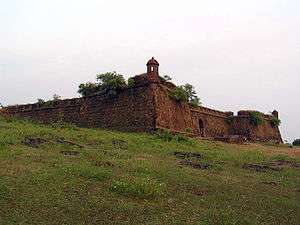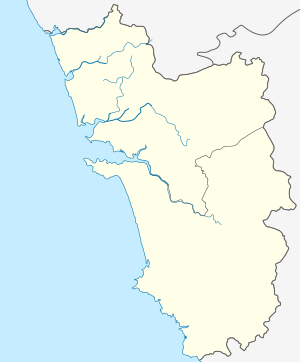Corjuem Fort
Corjuem Fort is a fortress situated 4 kilometres (2.5 mi) from the village of Aldona on the river island of Corjuem, Goa. It was a military fortress for the defense of Portuguese India. It is smaller than the other forts in Goa, but it gives a good view of the surrounding river and land. It is a protected monument under the Goa, Daman and Diu ancient monuments and archaeological sites and remains act.[1]
| Corjuem Fort | |
|---|---|
Forte de Corjuem | |
| Part of Portuguese Goa | |
| Bardez, Goa | |
 Forte de Corjuem, Goa | |
 Corjuem Fort | |
| Coordinates | 15.5968°N 73.8928°E |
| Type | Fortress battery |
| Site information | |
| Controlled by | Portuguese India(-1961) |
| Open to the public | Yes |
| Condition | Partial Ruin |
| Site history | |
| Built | 1705 |
| Built by | Caetano de Melo e Castro |
| In use | Abandoned in 1894 |
Corjuem Fort is 12 kilometres (7.5 mi) from Panjim.
Location
The Fort of Corjuem (Portuguese: Forte de Corjuem) is situated on an island with the same name in Bardez, to the east of the village of Aldona, from which it is separated by the Mapuçá River (a tributary of the Mandovi).
History
This fort built in 1705 is one of the only two inland forts that are surviving that are made of pitted laterite. The original occupiers of this Fort were the Desai's of Sankhali but it was traded into maratha hand later into Sawant-Bhonsle of Sawantwadi. Under the Portuguese Viceroy Caetano de Mello e Castro,[2] the control of the fort came under Portuguese India's administration.[3] The fort was subsequently rebuilt by the Portuguese to boost up defenses along Panajim. In the eighteenth century this fort protected the Portuguese from the Marathas, Bhonsles and the Rane Rajputs, who were camped just beyond the Mandovi River.
In the early 1800s, the fort was used as a Military School and had in its defenses a battery of four guns. The fortress defended the town of Corjuem and also had a chapel under parochial church of Aldona.[4]
Incidents
The fort also has an interesting incident in which an ambitious Portuguese woman named Ursula e Lancastre, who determined to see the man's world, dressed as a man and travelled the world. She landed up at Corjuem as a soldier but was later captured and stripped.[5]
References
- Fernandes, Joaquim (Aug 19, 2014). "Goa government to restore Corjuem fort". Times of India. Retrieved 21 August 2016.
- pt:Caetano de Melo e Castro, Retrieved 10 May 2012
- da Fonseca, José Nicolau (January 1878). Historical and Archaeological Sketch of the City of Goa. Thacker & Co. p. 85.
- da Fonseca, José Nicolau (January 1878). Historical and Archaeological Sketch of the City of Goa. Thacker & Co. p. 86.
- Bryn Thomas, Douglas Streatfeild-James (Feb 1998). Lonely Planet : Goa. 205: Lonely Planey. p. 285. ISBN 0864424884.CS1 maint: location (link)
- "Corjuem fort to be developed as heritage touristic destination". timesofindia. Oct 2018.